|
 Project
Describtion Project
Describtion  Parallel
Operation Parallel
Operation  Switching
Devices Switching
Devices  PLC PLC
 Matlab Matlab
مواقع
مفضله بحث
بحث  سجل الزوار
سجل الزوار  شكر وعرفان
شكر وعرفان  من
أنا من
أنا

 Introduction
to
Relays Introduction
to
Relays
 What
is a Relay? What
is a Relay?
Relays are generally used to switch
smaller currents in a control circuit and do not usually control power consuming
devices except for small motors and Solenoids
that draw low amps. Nonetheless, relays can "control" larger voltages
and amperes by having an amplifying effect because a small voltage (24V) applied
to a relay's coil can result in a large voltage (460V) being switched by the
contacts.
Figure 1. General
Purpose Relay
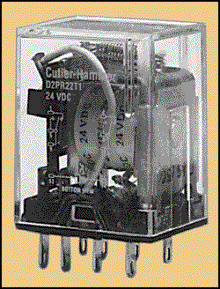
Relays are widely used to
heating elements, refrigerators, heating and air conditioning systems,
relays control the operation of machine tools, industrial assembly lines and
commercial equipment.
Relays are the electrical workhorses
that control one electrical circuit by opening and
closing Contacts
in another circuit. When a relay contact is Normally
Open (NO), there is an open contact when the relay is not energized.
When a relay contact is Normally
Closed (NC), there is a closed contact when the relay is not
energized. In either case, applying electrical current to the contacts will
change their state.
Although relays make things happen,
they can also keep things from happening. Protective relays can prevent
equipment damage by detecting electrical abnormalities, including overcurrent,
undercurrent, overloads and reverse currents.
 Types
of relayes Types
of relayes
1-electromechanical
2- solid-state.
In
an electromechanical relay, contacts are opened or closed by a magnetic force.
With a solid-state relay, there are no contacts and switching is totally
electronic.
Figure 2. Solid-State
Relay
Figure 3. general purpose relay
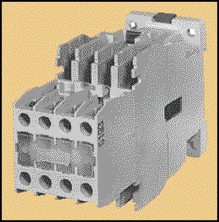
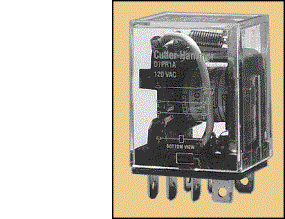
We'll cover electromechanical relays
first.
 General
Purpose Relay General
Purpose Relay
General Purpose Relays are
electromechanical switches, usually operated by a magnetic coil. General purpose
relays operate with AC or DC current, at common voltages such as 12V, 24V, 48V,
120V and 230V, and they can control currents ranging from 2A - 30A. These relays
are economical, easy to replace and allow a wide range of switch configuration.
 Machine
Control Relay Machine
Control Relay
Machine Control Relays are also
operated by a magnetic coil. They are heavy-duty relays used to control starters
and other industrial components. Although they are more expensive than general
purpose relays, they are generally more durable.
Figure 4. Machine
Control Relay
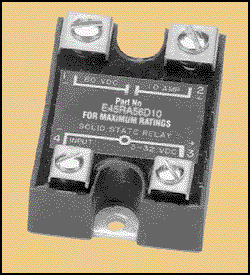
The biggest advantage of machine
control relays over general purpose relays is that you can easily expand the
function of this type of relay by adding accessories. A wide selection of
accessories are available for machine control relays, including additional
poles, convertible contacts
 Reed
Relay Reed
Relay
The fast operating Reed
Relay is a small, compact, switch design with one contact,
which is NO. The relay is hermetically sealed in a glass envelope, which makes
the contacts unaffected by contaminants, fumes or humidity, allows reliable
switching, and gives contacts a high life expectancy. The ends of the contact,
which are often plated with gold or another low resistance material to increase
conductivity, are drawn together and closed by a magnet. Reed relays are capable
of switching industrial components such as solenoids, contactors and starter
motors.
A reed relay consists
of two reeds. When a magnetic force is applied, typically by an electromagnet or
coil, it sets up a magnetic field in which the ends of the reeds assume opposite
polarity. When the magnetic field is strong enough, the attracting force of the
opposite poles overcomes the stiffness of the reeds and draws them together.
When the magnetic force is removed, the reeds spring back to their original,
open position. These relays work very quickly because of the short distance
between the reeds.
Figure 56. Reed Relay
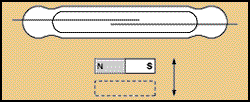
Electromechanical
Relay Parts
The basic parts of a coil relay
include:
●FRAME. Heavy-duty frame that
contains and supports the parts of the relay.
●COIL. Wire is wound around a
metal core. The coil of wire causes an electromagnetic field.
●ARMATURE. The moving part of
the relay that opens and closes the contacts. An attached spring returns the
armature to its original position.
●CONTACTS. The conducting part
of the switch that makes (closes) or breaks (opens) a circuit.
Figure 57.
Electromechanical Relay
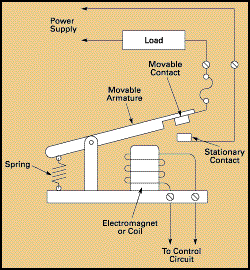
A relay involves two circuits: the
energizing circuit and the contact circuit. The coil is on the energizing side;
and the relay contacts are on the contact side.
When a relay coil is energized,
current flow through the coil creates a magnetic field. Whether in a DC unit
where the polarity is fixed, or in an AC unit where the polarity changes 120
times per second (for afrequency of 60 HZ), the basic function remains the same:
the magnetic coil attracts a ferrous plate, which is part of the armature. One
end of the armature is attached to the metal frame, which is formed so that the
armature can pivot, while the other end opens and closes the contacts.
Figure
58. Breaks, Poles and Throws
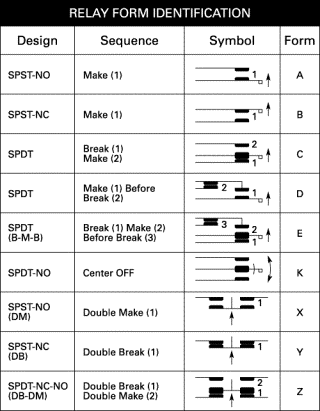
HOME NEXT
SWITCHING DEVICES MENU
|